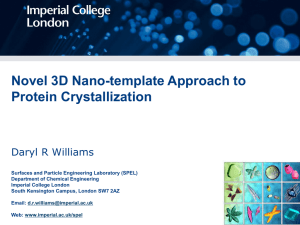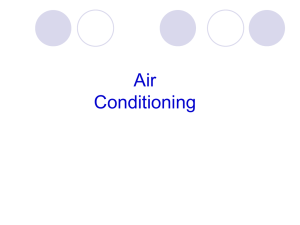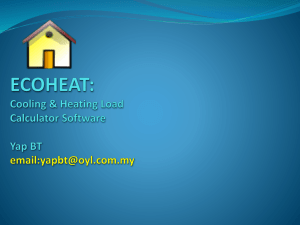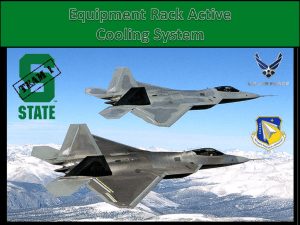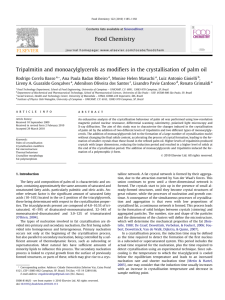Crystallisation Part II
advertisement
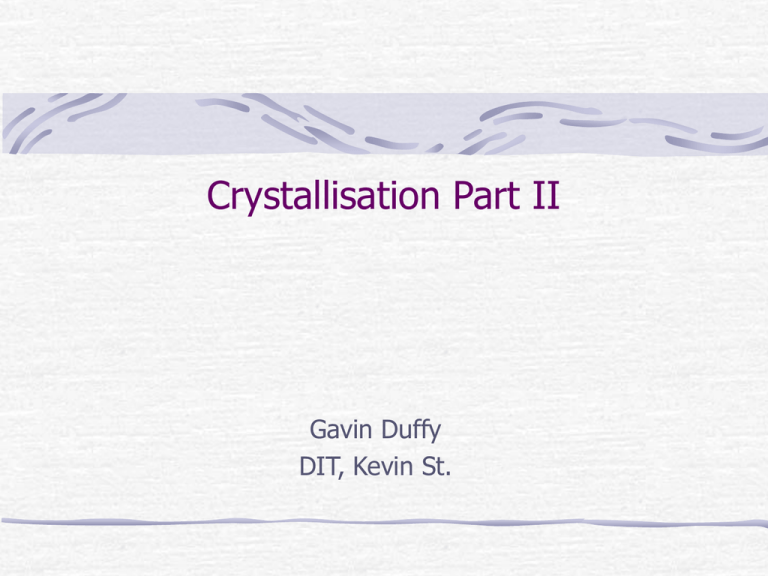
Crystallisation Part II Gavin Duffy DIT, Kevin St. Activity - A crystallisation Read the crystallisation procedure taken from a pharmaceutical company In groups of two, discuss the purpose of each step in the process Identify where the following events occur Nucleation Supersaturation Crystal growth Crystallisation by Cooling Supersaturation by cooling is the most popular method of crystallisation Most components have a strong solubility dependence on temperature Normally the crystallisation is achieved by following a cooling cycle where the crystalliser is cooled at a constant rate for a certain time Typical rates of cooling are slow, 0.1 or 0.2 °C/min Although the rate is slow, the physical dimensions of the reactor and jacket capacity limit the maximum rate possible The rate may be changed after a certain time period (e.g. 2 hours) This creates a linear temperature profile over time Typical Crystallisation by Cooling C, Temp The following linear temperature profile is often encountered Temp C time Optimal Cooling An alternative is to use a non linear temperature profile where rate of cooling is slow at the start and speeds up as the crystallisation progresses The rationale for this is as follows: Cool slowly at the start to keep C low to prevent high rates of nucleation. At this stage the rate of mass transfer from liquid to solid phase is slow As the surface area of the crystals increase, they can adsorb solute at a higher rate so the rate of cooling can be increased Supersaturation is in theory a constant over the entire duration of the crystallisation This results in a non linear temperature profile Optimal Cooling Non linear temperature profile C, Temp Temp C time Cooling and Seeding Addition of seed on its own creates crystallisation Therefore, there is no need to force crystallisation at the time of seeding as it is going to happen anyway Cooling at the same time may create high rates of crystallisation and a lot of fines Hold the temperature after seeding, do not cool This is known as an isothermal age Before supersaturation is lost completely, start cooling Optimal Cooling with Seeding Seeding Concentration MSZ Isothermal age Optimal Cooling Temperature Anti Solvent Additon Anti Solvent reduces solubility Creates the same result as cooling Can be treated like cooling, i.e. add slowly at the start and increase rate of addition with time Mixing is extremely important with anti solvent addition We want a homogenous mixture in the crystalliser but if mixing is not good, we will get regions of high anti solvent conc. and, as a result, high rates of crystallisation. Other areas will have little anti solvent and low rates of crystallisation C may vary throughout the crystalliser Anti Solvent Addition Anti solvent concentration and C will be highest near the anti solvent addition point Add anti solvent near the impeller Add anti solvent at a high velocity – use a thin pipe to increase velocity and dispersion of anti solvent throughout the vessel Add anti solvent at a number of points in the vessel Activity – Compare two SOPs Have a look at the two SOPs for crystallisation of the same API Compare the initial SOP to the one that was created to address the prevention of fines Solubility curve for this material: Solubility Curve 80 70 g solute/litre 60 50 40 30 20 10 0 0 10 20 30 40 50 Temp deg C 60 70 80 90 Crystallisation without thermal cycle Crystallisation with thermal cycle Mixing In a small lab scale vessel, mixing is good and homogeneity is quickly achieved This is not so in a large vessel. It takes a lot of mixing or a long time to create a homogenous mixture This can create scale up issues where problems that were never noticed in the lab become evident in the plant Fines prevention is important in crystallisation but high rates of agitation don’t tend to break up particles Low rates of mixing can also allow heavy particles to fall out of suspension Don’t be conservative with mixing – poor mixing is bad for crystallisation Measuring crystallisation Crystallisation is a mass transfer of solute from the liquid phase to the solid phase As crystallisation progresses The liquid phase concentration of the solute decreases The particle size and number of particles increase We can track crystallisation by measuring Liquid phase concentration Solid phase particle size Off line V In line measurement Off line involves removal of a sample from the vessel at regular intervals and transfer to a lab for measurement Issues Is the sample representative? Is it still crystallising? Can corrective action be taken? In line measurements (not temperature) are known as Process Analytic Technology or PAT Methods include FBRM React IR PVM USS FBRM Focused Beam Reflectance Measurement Focused laser beam in a rotating lens pointed into the crystalliser Focused just outside window Backscatter of light gives particle size Number of particles are counted also CSD data can be produced A large number of particles are counted and measured per revolution of laser (thousands) Location of probe important – usually in impeller region Lasentec Probe A laser beam focused just outside the probe window rotates around its circumference The beam intersects the edges of particles and light is backscattered until the beam reaches the far edge of the particle The distance measured is a chord length It can measure tens of thousands of chords per second Materials that do not backscatter such as opticalgrade glass beads cannot be measured with FBRM. FTIR Spectroscopy Fourier Transform Infra Red Spectroscopy Infra red beam pointed into crystalliser Reaction analysis in the liquid phase Can identify and monitor reaction species Needs an air purge to keep the view of the process free of solution material Air purge must be CO free as CO absorbs IR PVM and USS Particle Vision and Measurement Video microscope Image analysis of solid phase Ultra Sonic particle Sizing Sample stream taken from vessel and passed through the USS on a continuous basis Crystallisation Equipment CSTR is the most common in pharmaceuticals Tank crystalliser – non agitated vessel. Solution is allowed to cool by natural convection without interference Scraped surface crystalliser - a trough about 2 feet wide with a semi-circular bottom. The outside is jacketed with cooling coils and an agitator blade gently passes close to the trough wall removing crystals that grow on the vessel wall. Vacuum crystalliser – hot saturated solution is fed to a vessel which is under vacuum. At the new pressure, the solution is above boiling point. This helps in two ways. 1. The solution cools to the boiling point. 2. The solvent boils/evaporates. Activity – Process Variables Identify the process variables of Crystallisation What are the main process variables What are the connected process variables Draw a block diagram of a crystallisation system with feedback control. Identify Instrument Controlled Device Process
